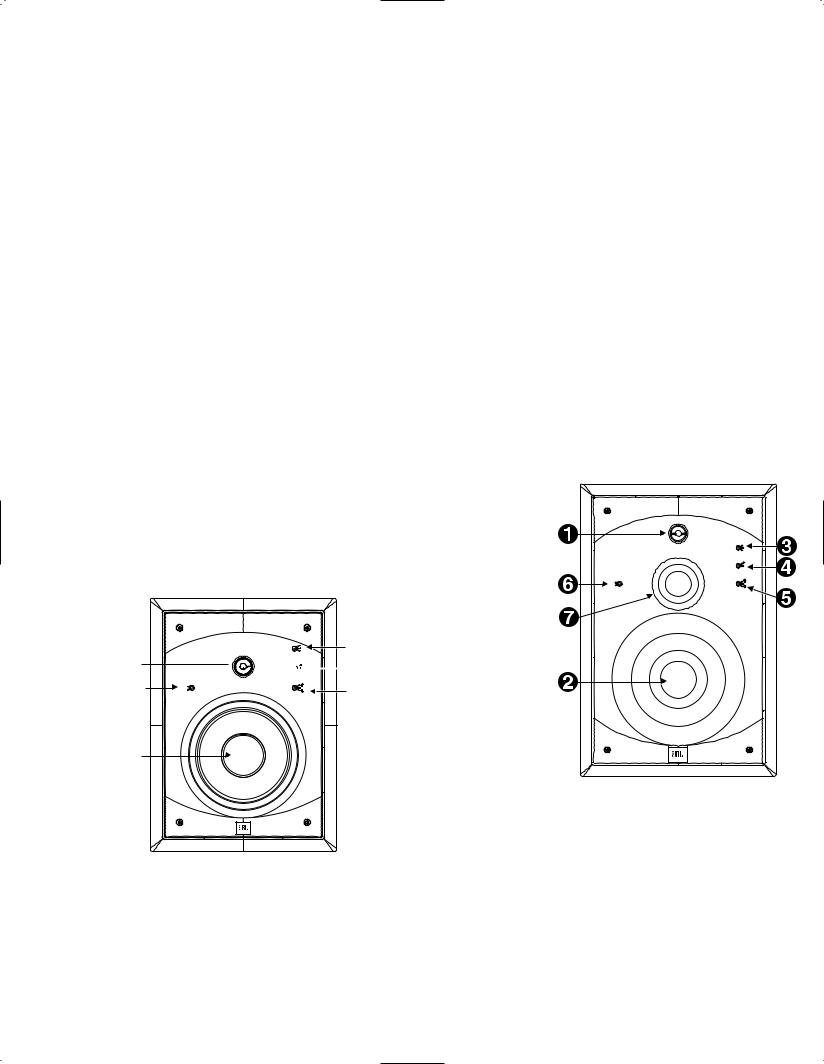JBL P81, P941 User Manual

JBL PERFORMANCE™ SERIES
OWNER’S GUIDE
P81
P941
HIGH-PERFORMANCE
IN-

P81/P941 IN-WALL LOUDSPEAKERS
3Documentation Conventions
4Introduction
4 Highlights
4Product Registration
5Unpacking
6Loudspeaker Overview
6Driver Complement
7Filter Network
7Input Panel
8Installation Considerations
8Loudspeaker Placement
9Installation Instructions
11Making Connections
12Optimizing Performance
13Loudspeaker Volume
14Specifications
14 Dimensions
14Obtaining Service
15Index
DOCUMENTATION CONVENTIONS
This document contains general safety, installation, and operation instructions for the JBL® Performance™ Series P81 and P941 In-Wall Loudspeakers. It is important to read this document before attempting to use your loudspeakers. Pay particular attention to safety instructions.
WARNING
Calls attention to a procedure, practice, condition, or the like that, if not correctly performed or adhered to, could result in injury or death.
CAUTION
Calls attention to a procedure, practice, condition, or the like that, if not correctly performed or adhered to, could result in damage to or destruction of part or all of the product.
NOTE
Calls attention to information that is essential to highlight.
®3

INTRODUCTION
Thank you for purchasing the JBL Performance Series P81/P941 In-Wall Loudspeakers. Designed for discerning audiophiles, the P81 and P941 offer versatile, easily integrated in-wall loudspeakers that provide the superior, uncolored sound that is the hallmark of JBL loudspeakers. The P81 and P941 reproduce realistic, accurate signals with minimal coloration and distortion, making them perfect complements to JBL Performance front speakers in multichannel setups. Proprietary transducers, sophisticated filter networks, and user-adjustable compensation controls allow the P81/P941 to achieve remarkable sound quality and performance befitting the most demanding home entertainment systems.
The P81 and P941 are also perfectly suited as front and surround speakers in complete in-wall setups, or as stereo pairs in secondary listening spaces, or for integration with flat-screen television home theater installations. Unlike freestanding loudspeakers, the P81 and P941 speakers occupy no space in living areas and will not detract from the décor of the listening room. They are easily mounted in either pre-existing or new construction projects.
A critical aspect of loudspeaker design, transducers convert electrical signals into audible sounds, profoundly affecting speaker performance. Combining superior form and function, the P81 and P941 transducers feature a distinctive design that allows for smoother frequency response. The cones are constructed with Organic Ceramic Composite cone material to reduce distortion, while the spiders are constructed of a high-strength Nomex® blend with optimized geometry for increased linearity.
A two-way design, the P81 transducers effectively cover a broad range of frequencies. A 7-1/2-inch (191mm) woofer delivers highly refined and dynamically authoritative low frequencies down to the very lowest octaves. Also, a 1-inch (25mm) titanium-dome tweeter reproduces high frequencies well above audible levels, with wide dispersion for open, airy treble.
A three-way design, the P941, in addition to its 9-inch (229mm) woofer and 1-inch (25mm) tweeter, also features a 3-1/2-inch (89mm) midrange, which
handles critical mid-band frequencies with natural tonal balance over a wide operating range.
An advanced midrange (P941 only) motor structure includes two highgrade neodymium magnets placed at the center of the motor structure, inside the voice coil, for improved
magnetic shielding. Inside the motor, a black-plated steel-shield cup facilitates heat dissipation for higher power handling. An integrated aluminum fluxstabilization ring minimizes modulation inside the motor’s static gap flux field, greatly reducing distortion. A copper ring inside the motor’s gap reduces distortion even further. Both rings are optimally sized and placed to maintain constant linear voice coil inductance with forward and backward motions.
The P81 has a high-order filter at 2.8kHz. In the P941, high-order filters at 300Hz and 2kHz optimize loudspeaker onand off-axis response, helping
to ensure smooth octave-to-octave balance and timbral accuracy. The P81 and P941 feature gold-plated binding posts that accommodate two connection methods, while separate HighFrequency Tilt, Low-Frequency Boundary Compensation, High-Frequency Level and Listener Axis controls compensate for less-than-ideal listening room acoustics and loudspeaker placement.
For more than 50 years, JBL has stood at the forefront of loudspeaker design. With extensive research and design facilities, the JBL Performance Series P81 and P941 loudspeakers benefit from cutting-edge tools such as a multichannel listening lab for double-blind listening tests; a laser interferometer for detailed driver analysis; real anechoic chambers for precise tests and measurements; finite element analysis for advanced loudspeaker modeling; and a stereo lithography apparatus for design verification.
Adding to the proud lineage of JBL’s Performance Series loudspeakers, the P81 and P941 further advance JBL’s reputation as the leading designer and manufacturer of high-quality, high-performance loudspeakers.
P81/P941 HIGHLIGHTS
■Exceptional accuracy
■Proprietary 7-1/2-inch (191mm)/9-inch (229mm) Organic Ceramic Composite woofer
■Proprietary 3-1/2-inch (89mm) Organic Ceramic Composite midrange (P941 only)
■Proprietary 1-inch (25mm) titaniumdome tweeter
■High output with low distortion
■Gold-plated binding posts
■High-Frequency Level control
■High-Frequency Tilt control
■Low-Frequency Boundary Compensation control
■Listener Axis control
■Advanced woofer and midrange (P941 only) motor structure
■Large voice coils for wide dynamic range without compression
■Wall-mounting frame which features spring-loaded clamps to securely anchor loudspeaker into wall opening
■Optional rough-in bracket for studmounting prior to drywall installation (not included)
PRODUCT REGISTRATION
Please register the P81/P941 as soon as possible after purchase. To do so, register online at www.jbl.com. The product registration serves no warranty purposes. Retain the original, dated sales receipt as proof of warranty coverage.
4

UNPACKING
The P81 and P941 require special care and handling during unpacking. Pay particular attention to the precautions that appear in this section and to other precautions that appear throughout this owner’s manual.
When unpacking, save all packing materials for possible future shipping needs. Refer to the Obtaining Service section on page 14 for additional information.
™
 ¡
¡
£
Figure 1: Unpacking the P81/P941
To Unpack the P81 and P941:
1.Place the packing carton in the upright position and fully open the top flaps, as shown in Step 1 of Figure 1.
2.Without allowing the top flaps to close, move the outer packing carton into an inverted position, as shown in Step 2 of Figure 1.
3.Lift the packing carton off of the loudspeaker, as shown in Step 3 of Figure 1. Use caution to avoid
damaging the loudspeaker or frame clamps. At this point, the loudspeaker will be upside-down.
4.Remove the bottom pad, and then remove the frame alignment tool and grille from the grille filler. These items are identified in Figure 2.
5.Set aside the wall template, paint mask, fiberglass insulation, spacer shim, replacement scrim cloth and Allen keys.
6.Invert speaker so it is in the upright position.
7.When the P81/P941 is in the upright position, remove the top pad.
8.Leave the loudspeaker upright in the bottom pad until ready to install.
Allen Keys/Spacer Shim |
|
T |
|
Paint Mask |
Protective |
W Template |
Cloth |
|
|
|
Fiberglass |
Grille |
Insulation |
Frame |
|
|
Alignment Tool |
|
Replacement |
|
Bottom Pad |
Scrim Cloth |
|
|
|
Figure 2: Packing Materials |
|
|
5

LOUDSPEAKER OVERVIEW
P81/P941 DRIVER COMPLEMENT |
3. High-Frequency Level (dB) Control |
The numbers in Figure 3 correspond to the numbered items in this section.
1. Tweeter
•1-inch (25mm) titanium dome
•Underhung with copper-clad aluminum wire for low distortion
•Ferrofluid for high-power handling with reduced compression
2. Woofer
•7-1/2-inch (191mm)/9-inch (229mm) cones constructed with Organic Ceramic Composite cone material for low distortion
•True pistonic operation for increased freedom from coloration
•Symmetrical Field Geometry (SFG™) design for low overall distortion
•Aluminum ring for flux stabilization greatly reduces distortion at low frequencies
•Butyl rubber surround for large, linear excursion capabilities
•Carbon composite aluminum (CCA) flatwire voice coil wound on a 1-1/2- inch (38mm) fiberglass bobbin for low mass and higher power handling
•Vented center pole for improved heat dissipation and low compression
|
–1 |
£ |
High Frequency Level (dB) |
+1 |
|
0 |
|
¡


 High Frequency Tilt
High Frequency Tilt 0
0 ¢
¢
§ |
on |
Low Frequency |
|
|
∞ |
|
B |
|
Listener Axis |
on a |
|||
o f |
|
|||||
C |
nsation |
|
|
|||
™
The numbers in Figure 3 correspond to the numbered items in the Driver Complement section.
Figure 3: P81 Speaker (Front View)
Provides a shift in the output level of the tweeter or overall high-frequency response (active above approximately 2.5kHz). The options are –1dB, 0dB and +1dB.
4. High-Frequency Tilt Control
Adds a ”tilt“ to the high-frequency response. The tilt will become active above approximately 8kHz (depart from nominally flat response) and will increase to 3dB – 4dB at 20kHz. This will offer an improved high-frequency response for installations where the primary listening position is located significantly off the tweeter axis (for an effect almost like adding ”toe in“ towards the listening position). The added highfrequency contour helps to offset perceived reduction of high-frequency response for off-axis listeners due to the increase in directivity of the system (tweeter beaming) above 8kHz.
5. Listener Axis Control
All loudspeakers sound best when the listener is positioned at optimal angles relative to the speaker placement. This is a fixed angle for most loudspeakers, but the P81 and P941 provide compensation for much greater placement flexibility. The listener axis control, used in conjunction with the placement of the speaker, can obtain excellent results in a very wide range of circumstances. This control optimizes system response for installations in which the listening positions are lower than, higher than, or directly level with the tweeter. This switch will be active
in the network transition regions between the woofer and tweeter (in the P81) and the midrange and tweeter (in the P941).
•Select the “high” (up arrow) setting if the speaker is mounted so that the listener is at tweeter level or above.
•Select the “on axis” setting if the listener position is located directly on axis with the tweeter level.
•Select the “low” (down arrow) setting if the speaker is mounted so that the listener is below tweeter level.
NOTE: In some circumstances, such as when the speaker is to be mounted high on the wall towards the ceiling, it may be desired to invert the speaker in order to place the tweeter axis closer to the listener’s ear level. The Listener Axis Control will also optimize these
inverted speaker installations. Refer to the Notes on page 9 and the Optimizing Performance (page 12) section for additional information.
6. Low-Frequency Boundary
Compensation Control
Compensates for less-than-ideal speaker placement near adjacent walls or boundaries.
•Select the “off” setting if the speaker is mounted at least 4 feet away from adjacent walls or boundaries.
•Select the “on” position if the speaker is less than 4 feet from one (or possibly two) or more adjacent walls or boundaries. In the ”on“ position, system output is reduced below approximately 400Hz to offset the increased low-frequency support, due to the boundary.
NOTE: Refer to the Optimizing Performance section on page 12 for more information about the front-panel controls.
|
H |
requency Level (dB) |
+1 |
|
|
0 |
|||
|
|
|
–1 |
|
|
|
High Frequency Tilt |
0 |
|
on |
Low Frequency |
Listener Axis |
|
|
Boundary |
on a |
|||
off |
||||
Compensation |
|
|
||
|
|
|
The numbers in Figure 4 correspond to the numbered items in the Driver Complement section.
Figure 4: P941 Speaker (Front View)
7. Midrange (P941 Only)
•3-1/2-inch (89mm) cone constructed with Organic Ceramic Composite material
•Die-cast basket to eliminate coloration from resonances
•True pistonic operation for increased freedom from coloration
6
